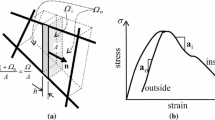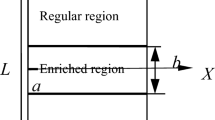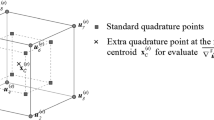Abstract
Numerical modeling of crack propagation is still a pressing issue in fracture mechanics. The finite element method and its variations are usually used for this purpose. One of the possibilities for modeling crack propagation is the well-known cohesive fracture mechanics. Generally, commercial finite element programs use a predefined cohesive zone, i.e., inter-element cracking modeling. Alternatively, this paper proposes a numerical strategy where the cohesive cracks can nucleate and propagate at any finite element, i.e., intra-element cracking modeling. The numerical results show a good agreement between both models when the cohesive zone is predefined. Moreover, when compared to a bending experiment on a tunnel lining segment where cracks can appear anywhere, the proposed model (the intra-element cohesive cracking model) presents good accuracy where different cracks nucleate and propagate.













Similar content being viewed by others
References
Paris PC (1998) Fracture mechanics and fatigue: a historical perspective. Fatigue Fract Eng Mater Struct 21:535–540. https://doi.org/10.1046/j.1460-2695.1998.00054.x
Cotterell B (2002) The past, present and future of fracture mechanics. Eng Fract Mech 69:533–553. https://doi.org/10.1016/S0013-7944(01)00101-1
Zhu X-K, Joyce JA (2012) Review of fracture toughness (G, K, J, CTOD, CTOA) testing and standardization. Eng Fract Mech 85:1–46. https://doi.org/10.1016/j.engfracmech.2012.02.001
Behroozinia P, Mirzaeifar R, Taheri S (2019) A review of fatigue and fracture mechanics with a focus on rubber-based materials. Proc Inst Mech Eng, Part L: J Mater: Des Appl 233(5):1005–1019. https://doi.org/10.1177/1464420717719739
Marșavina L, Linul E (2020) Fracture toughness of rigid polymeric foams: a review. Fatigue Fract Eng Mater Struct 43:2483–2514. https://doi.org/10.1111/ffe.13327
Poli R, Gioria R, Carrion R (2021) A poroelastic simulator with hydraulic fracture propagation using cohesive finite elements. J Braz Soc Mech Sci Eng 43:175. https://doi.org/10.1007/s40430-020-02787-4
Jen MHR, Wu YJ, Wu YH, Huang WP (2023) Numerical analysis and experimental verification on crack growth and fatigue life in double-edge cracked metal plates. J Braz Soc Mech Sci Eng 45:56. https://doi.org/10.1007/s40430-022-03982-1
Sinha GP, Kumar B (2023) Fracture analysis of cracked thin plate by NURBS-based extended finite element method. J Braz Soc Mech Sci Eng 45:192. https://doi.org/10.1007/s40430-023-04116-x
Sharma P, Mali HS, Dixit A (2023) Mode-I interlaminar fracture modeling of DCB composite laminate using finite element techniques. J Braz Soc Mech Sci Eng 45:512. https://doi.org/10.1007/s40430-023-04427-z
Han J, Hirayama D, Shintaku Y, Moriguchi S, Terada K (2024) Crack phase-field enhanced finite cover method for dynamic fracture at finite strain. Int J Numer Methods Eng 125:e7371. https://doi.org/10.1002/nme.7371
Park T, Kitahara A, Ishina T, Hamada S, Noguchi H (2023) Proposal of new crack-tip-opening-displacement as a mechanical driving force of elastic-plastic fracture mechanics. J Theor Appl Mech 128:104116. https://doi.org/10.1016/j.tafmec.2023.104116
Chen Z, Yang D, Bian H (2023) Peridynamic modeling of crack propagation driven by hydrogen embrittlement. Eng Fract Mech 293:109687. https://doi.org/10.1016/j.engfracmech.2023.109687
Wang W, Ni K, Ma H, Xiong Q, Wu Z, Wang H, Fan C (2023) Fatigue crack propagation simulation of airfoil section blade under aerodynamic and centrifugal loads. Eng Fract Mech 293:109702. https://doi.org/10.1016/j.engfracmech.2023.109702
Koenke C, Harte R, Krätzig WB, Rosenstein O (1998) On adaptive remeshing techniques for crack simulation problems. Eng Comput 15(1):74–88. https://doi.org/10.1108/02644409810200695
Khoei AR, Azadi H, Moslemi H (2008) Modeling of crack propagation via an automatic adaptive mesh refinement based on modified superconvergent patch recovery technique. Eng Fract Mech 75:2921–2945. https://doi.org/10.1016/j.engfracmech.2008.01.006
Dai S, Augarde C, Du C, Chen D (2015) A fully automatic polygon scaled boundary finite element method for modelling crack propagation. Eng Fract Mech 133:163–178. https://doi.org/10.1016/j.engfracmech.2014.11.011
Uribe-Suárez D, Bouchard P-O, Delbo M, Pino-Muñoz D (2023) Numerical modeling of crack propagation with dynamic insertion of cohesive elements. Eng Fract Mech 227:106918. https://doi.org/10.1016/j.engfracmech.2020.106918
Wang C, Ping X, Wang X (2023) An adaptive finite element method for crack propagation based on a multifunctional super singular element. Int J Mech Sci 247:108191. https://doi.org/10.1016/j.ijmecsci.2023.108191
Duarte CA, Oden JT (1996) H-p clouds—an h-p meshless method. Numer Methods Partial Differ Eq 12:673–705. https://doi.org/10.1002/(SICI)1098-2426(199611)12:6%3c673::AID-NUM3%3e3.0.CO;2-P
Belytschko T, Lu YY, Gu L (1994) Element-free galerkin methods. Int J Numer Meth Eng 37(2):229–256. https://doi.org/10.1002/nme.1620370205
Fleming M, Chu YA, Moran B, Belytschko T (1997) Enriched element-free galerkin methods for crack tip fields. Int J Numer Methods Eng 40(8):1483–1504. https://doi.org/10.1002/(SICI)1097-0207(19970430)40:8%3C1483::AID-NME123%3E3.0.CO;2-6
Gonçalves DC, Sánchez-Arce IJ, Ramalho LDC, Campilho RDSG, Belinha J (2022) Fracture propagation based on meshless method and energy release rate criterion extended to the Double Cantilever Beam adhesive joint test. Theor Appl Fract Mech 122:103577. https://doi.org/10.1016/j.tafmec.2022.103577
Moës N, Dolbow J, Belytschko T (1999) A finite element method for crack growth without remeshing. Int J Numer Meth Eng 46(1):131–150. https://doi.org/10.1002/(SICI)1097-0207(19990910)46:13.0.CO;2-J
Park K, Pereira JP, Duarte CA, Paulino GH (2009) Integration of singular enrichment functions in the generalized/extended finite element method for three-dimensional problems. Int J Numer Meth Eng 78:1220–1257. https://doi.org/10.1002/nme.2530
Malekan M, Barros FB (2016) Well-conditioning global–local analysis using stable generalized/extended finite element method for linear elastic fracture mechanics. Comput Mech 58:819–831. https://doi.org/10.1007/s00466-016-1318-7
Ammendolea D, Greco F, Leonetti L, Leonetti P, Pascuzzo A, Penna R (2023) A moving mesh-based numerical investigation of the failure response of nano-filled ultra-high-performance concrete structures. Procedia Struct Integr 47:488–502. https://doi.org/10.1016/j.prostr.2023.07.075
Marandi SM, Badnava H, Dehkordi MB, Nourbakhsh SH (2021) Phase-field modeling of coupled anisotropic plasticity–ductile fracture in rate-dependent solids. J Braz Soc Mech Sci Eng 43:229. https://doi.org/10.1007/s40430-021-02945-2
Leão HM, Pitangueira RLS, Gori L, Penna SS (2021) Phase-field modelling of size effect on strength and structural brittleness. J Braz Soc Mech Sci Eng 43:484. https://doi.org/10.1007/s40430-021-03197-w
Wu J-Y, Huang Y, Nguyen VP, Mandal TK (2022) Crack nucleation and propagation in the phase-field cohesive zone model with application to Hertzian indentation fracture. Int J Solids Struct 241:111462. https://doi.org/10.1016/j.ijsolstr.2022.111462
Konica S, Sain T (2023) Phase-field fracture modeling for unidirectional fiber-reinforced polymer composites. Eur J Mech A-Solid 100:105035. https://doi.org/10.1016/j.euromechsol.2023.105035
Rashid MM (1997) A computational procedure for simulation of crack advance in arbitrary two-dimensional domains. Comput Mech 20:133–138. https://doi.org/10.1007/s004660050229
Chen L, Li B, de Borst R (2020) Adaptive isogeometric analysis for phase-field modeling of anisotropic brittle fracture. Int J Numer Methods Eng 121(20):4630–4648. https://doi.org/10.1002/nme.6457
Li H, Jiang H, Yang W (2023) An extended multiphase hybrid-stress finite element method for modelling interface crack propagation between two dissimilar materials. Appl Math Model 122:60–98. https://doi.org/10.1016/j.apm.2023.05.014
Almeida LPR, Lima Junior ET, Barbirato JCC (2022) Probabilistic dipole BEM model for cohesive crack propagation analysis. J Braz Soc Mech Sci Eng 44:485. https://doi.org/10.1007/s40430-022-03765-8
Comi C, Perego U (2001) Fracture energy based bi-dissipative damage model for concrete. Int J Solids Struct 38:6427–6454. https://doi.org/10.1016/S0020-7683(01)00066-X
Feng D-C, Ren X-D, Li J (2018) Softened damage-plasticity model for analysis of cracked reinforced concrete structures. J Struct Eng 144(6):04018044. https://doi.org/10.1061/(ASCE)ST.1943-541X.0002015
Pereira Junior WM, Borges RA, Araújo DL, Fernandes GR (2023) Pituba JJC (2022) parametric identification and sensitivity analysis combined with a damage model for reinforced concrete structures. Arab J Sci Eng 48:4751–4767. https://doi.org/10.1007/s13369-022-07132-6
Wang J, Poh LH, Guo X (2023) Localizing gradient damage model based on a decomposition of elastic strain energy density. Eng Fract Mech 279:109032. https://doi.org/10.1016/j.engfracmech.2022.109032
Xue L, Ren X, Ballarini R (2023) Damage-plasticity modeling of shear failure in reinforced concrete structures. Eng Fract Mech 290:109536. https://doi.org/10.1016/j.engfracmech.2023.109536
Yang S-Q, Hu B, Xu P (2019) Study on the damage-softening constitutive model of rock and experimental verification. Acta Mech Sinica 35(4):786–798. https://doi.org/10.1007/s10409-018-00833-y
Sun X, Shi F, Luan Z, Ding J, He L, Zhang Y (2023) Constitutive model and microscopic mechanism for sandstone strength softening damage. Rock Mech Rock Eng 56:797–813. https://doi.org/10.1007/s00603-022-03096-z
Xavier J, Oliveira M, Morais JJL, de Moura MFSF (2014) Determining mode I cohesive law of Pinus pinaster by coupling double cantilever beam test with digital image correlation. Frat ed Integrita Strutt 9(31):13–22. https://doi.org/10.3221/IGF-ESIS.31.02
Kesava Rao B, Balu AS (2019) Modeling of delamination in fiber-reinforced composite using high-dimensional model representation-based cohesive zone model. J Braz Soc Mech Sci Eng 41:254. https://doi.org/10.1007/s40430-019-1761-4
Park K, Choi H, Paulino GH (2016) Assessment of cohesive traction-separation relationships in ABAQUS: a comparative study. Mech Res Comm 78:71–78. https://doi.org/10.1016/j.mechrescom.2016.09.004
Abaqus 6.13 Analysis User’s Manual, SIMULIA, Providence, IR, 2013.
Xu XP, Needleman A (1994) Numerical simulations of fast crack growth in brittle solids. J Mech Phys Solids 42(9):1397–1434. https://doi.org/10.1016/0022-5096(94)90003-5
Florez-Lopez J, Benallal A, Geymonat G, Billardon R (1994) A two-field finite element formulation for elasticity coupled to damage. Comput Methods Appl Mech Eng 114(3–4):193–212. https://doi.org/10.1016/0045-7825(94)90171-6
Camacho GT, Ortiz M (1996) Computational modelling of impact damage in brittle materials. Int J Solids Struct 33(20–22):2899–2938. https://doi.org/10.1016/0020-7683(95)00255-3
Amorim DLNF, Piedade Neto D, Proença SPB, Flórez-López J (2018) The extended lumped damage mechanics: A new formulation for the analysis of softening with FE size-independence. Mech Res Comm 91:13–18. https://doi.org/10.1016/j.mechrescom.2018.05.001
Picón RA, Santos DM, Teles DVC, Amorim DLNF, Zhou X, Bai Y, Proença SPB, Flórez-López J (2022) Modeling of localization using Nash variational formulations: The extended damage mechanics. Eng Fract Mech 258:108083. https://doi.org/10.1016/j.engfracmech.2021.108083
Abbas S, Soliman AM, Nehdi ML (2014) Mechanical Performance of Reinforced Concrete and Steel Fiber-Reinforced Concrete Precast Tunnel Lining Segments: A Case Study. ACI Mater J 111(5):501–510. https://doi.org/10.14359/51687101
Acknowledgements
The first author acknowledges CNPq (Conselho Nacional de Desenvolvimento Científico e Tecnológico), Brazil, for the grant 436523/2018-3 (Chamada Universal CNPq MCTIC) and the Scientific Computing and Visualization Laboratory of the Federal University of Alagoas (LCCV/UFAL) for access to an ABAQUS® license. The first and third authors acknowledge the Laboratory of Mathematical Modeling in Civil Engineering of the Disaster Research Institute of the Federal University of Sergipe (LAMEC/IPD/UFS) for the physical support during this investigation.
Author information
Authors and Affiliations
Corresponding author
Additional information
Technical Editor: João Marciano Laredo dos Reis.
Publisher's Note
Springer Nature remains neutral with regard to jurisdictional claims in published maps and institutional affiliations.
Rights and permissions
Springer Nature or its licensor (e.g. a society or other partner) holds exclusive rights to this article under a publishing agreement with the author(s) or other rightsholder(s); author self-archiving of the accepted manuscript version of this article is solely governed by the terms of such publishing agreement and applicable law.
About this article
Cite this article
Amorim, D.N., Picón, R., Vieira, C.d. et al. Intra-element versus inter-element crack propagation: the numerical extensometer approach. J Braz. Soc. Mech. Sci. Eng. 46, 360 (2024). https://doi.org/10.1007/s40430-024-04951-6
Received:
Accepted:
Published:
DOI: https://doi.org/10.1007/s40430-024-04951-6




